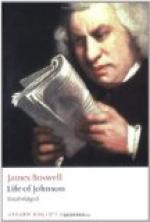[178] In The Tatler, for May 24, 1709, we are told that ’rural esquires wear shirts half a week, and are drunk twice a day.’ In the year 1720, Fenton urged Gay ’to sell as much South Sea stock as would purchase a hundred a year for life, “which will make you sure of a clean shirt and a shoulder of mutton every day."’ Johnson’s Works, viii. 65. In Tristram Shandy, ii. ch. 4, published in 1759, we read:—’It was in this year [about 1700] that my uncle began to break in upon the daily regularity of a clean shirt.’ In the Spiritual Quixote, published in 1773 (i. 51), Tugwell says to his master:—’Your Worship belike has been used to shift you twice a week.’ Mrs. Piozzi (Journey, i. 105, date of 1789) says that she heard in Milan ’a travelled gentleman telling his auditors how all the men in London, that were noble, put on a clean shirt every day.’ Johnson himself owned that he had ’no passion for clean linen.’ Ante, i. 397.
[179] Scott, in Old Mortality, ed. 1860, ix. 352, says:—’It was a universal custom in Scotland, that, when the family was at dinner, the outer-gate of the court-yard, if there was one, and if not, the door of the house itself, was always shut and locked.’ In a note on this he says:—’The custom of keeping the door of a house or chateau locked during the time of dinner probably arose from the family being anciently assembled in the hall at that meal, and liable to surprise.’
[180] Johnson, writing of ‘the chapel of the alienated college,’ says:—’I was always by some civil excuse hindered from entering it.’ Works, ix. 4.
[181] George Marline’s Reliquiae divi Andreae was published in 1797.
[182] See ante, ii. 171, and iv. 75.
[183] Mr. Chambers says that Knox was buried in a place which soon after became, and ever since has been, a high-way; namely, the old church-yard of St. Giles in Edinburgh. Croker’s Boswell, p. 283.
[184] In The Rambler, No. 82, Johnson makes a virtuoso write:—’I often lamented that I was not one of that happy generation who demolished the convents and monasteries, and broke windows by law.’ He had in 1754 ’viewed with indignation the ruins of the Abbeys of Oseney and Rewley near Oxford.’ Ante, i. 273. Smollett, in Humphry Clinker (Letrer of Aug. 8), describes St. Andrews as ’the skeleton of a venerable city.’
[185] ’Some talked of the right of society to the labour of individuals, and considered retirement as a desertion of duty. Others readily allowed that there was a time when the claims of the publick were satisfied, and when a man might properly sequester himself to review his life and purify his heart.’ Rasselas, ch. 22.
[186] See ante, ii. 423.
[187] See ante, iv. 5, note 2, and v. 27.
[188] ’He that lives well in the world is better than he that lives well in a monastery. But, perhaps, every one is not able to stem the temptations of publick life, and, if he cannot conquer, he may properly retreat.’ Rasselas, ch. 47. See ante, ii. 435.




